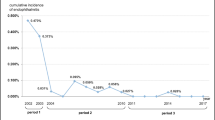Abstract
Purpose
To study the impact of prophylactic intracameral (IC) moxifloxacin on the incidence, clinical profile and outcomes in eyes developing post-cataract surgery endophthalmitis (PCE).
Methods
This was a single-centre, retrospective, comparative, observational study in which all eyes with PCE between June 2013 and May 2014 without IC moxifloxacin prophylaxis (group A) and June 2015–May 2016 with IC moxifloxacin prophylaxis (group B) were analysed.
Results
A total of 101,815 cataract surgeries were performed in group A and 112,967 in group B. PCE was diagnosed in 179 eyes (0.18%) in group A and 92 eyes (0.08%) in group B (p < 0.001). Greater reduction in risk of PCE was seen in subsidised patients compared to private. The presenting and final visual acuity was significantly better in group B (p < 0.05).
Conclusions
Prophylactic IC moxifloxacin reduced the incidence of PCE with maximum benefit being observed for the subsidised patients and also helped achieve a significantly better visual acuity following the resolution of endophthalmitis.
Similar content being viewed by others
Data availability
Data are available upon request.
References
Endophthalmitis Study Group, European Society of Cataract & Refractive Surgeons. Prophylaxis of postoperative endophthalmitis following cataract surgery: results of the ESCRS multicenter study and identification of risk factors. J Cataract Refract Surg 2007;33:978‐988
Speaker MG, Milch FA, Shah MK et al (1991) Role of external bacterial flora in the pathogenesis of acute postoperative endophthalmitis. Ophthalmology 98:639–650
Haripriya A, Chang DF, Namburar S et al (2016) Efficacy of intracameral moxifloxacin endophthalmitis prophylaxis at Aravind Eye Hospital. Ophthalmology 123:302–308
Haripriya A, Chang DF, Ravindran RD (2017) Endophthalmitis reduction with intracameral moxifloxacin prophylaxis: analysis of 600 000 surgeries. Ophthalmology 124:768–775
Results of the Endophthalmitis Vitrectomy Study (1995) A randomized trial of immediate vitrectomy and of intravenous antibiotics for the treatment of postoperative bacterial endophthalmitis. Endophthalmitis Vitrectomy Study Group Arch Ophthalmol 113:1479–1496
Jambulingam M, Parameswaran SK, Lysa S et al (2010) A study on the incidence, microbiological analysis and investigations on the source of infection of postoperative infectious endophthalmitis in a tertiary care ophthalmic hospital: an 8-year study. Indian J Ophthalmol 58:297–302
Ravindran RD, Venkatesh R, Chang DF et al (2009) Incidence of post-cataract endophthalmitis at Aravind Eye Hospital: outcomes of more than 42,000 consecutive cases using standardized sterilization and prophylaxis protocols. J Cataract Refract Surg 35:629–636
Npcbvi.gov.in. 2020. NPCBVI. [online] Available at: <https://npcbvi.gov.in/> [Accessed 8 August 2020]
Chang DF, Braga-Mele R, Mamalis N et al (2007) Prophylaxis of postoperative endophthalmitis after cataract surgery: results of the 2007 ASCRS member survey. J Cataract Refract Surg 33:1801–1805
Arbisser LB (2008) Safety of intracameral moxifloxacin for prophylaxis of endophthalmitis after cataract surgery. J Cataract Refract Surg 34:1114–1120
Lane SS, Osher RH, Masket S et al (2008) Evaluation of the safety of prophylactic intracameral moxifloxacin in cataract surgery. J Cataract Refract Surg 34:1451–1459
Matsuura K, Miyoshi T, Suto C et al (2013) Efficacy and safety of prophylactic intracameral moxifloxacin injection in Japan. J Cataract Refract Surg 39:1702–1706
Rathi VM, Sharma S, Das T et al (2020) Endophthalmitis prophylaxis study. Report 1: intracameral cefuroxime and moxifloxacin prophylaxis for the prevention of postcataract endophthalmitis in rural India. Indian J Ophthalmol 68:819–824
Celebi S, Ay S, Aykan U, Bulut V, Alagöz G, Celiker UO (1998) Penetration of oral and topical ciprofloxacin into human aqueous humor. Acta Ophthalmol Scand 76(6):683–685
Venkatesh R, Muralikrishnan R, Balent LC et al (2005) Outcomes of high volume cataract surgeries in a developing country. Br J Ophthalmol 89:1079–1083
Ruit S, Tabin G, Chang D et al (2007) A prospective randomized clinical trial of phacoemulsification vs manual sutureless small-incision extracapsular cataract surgery in Nepal. Am J Ophthalmol 143:32–38
Haripriya A, Chang DF, Reena M et al (2012) Complication rates of phacoemulsification and manual small-incision cataract surgery at Aravind Eye Hospital. J Cataract Refract Surg 38:1360–1369
Cao H, Zhang L, Li L et al (2013) Risk factors for acute endophthalmitis following cataract surgery: a systematic review and meta-analysis. PLoS ONE 8:e71731
Haripriya A, Chang DF, Ravindran RD (2019) Endophthalmitis reduction with intracameral moxifloxacin in eyes with and without surgical complications: results from 2 million consecutive cataract surgeries. J Cataract Refract Surg 45:1226–1233
Arshinoff SA, Felfeli T, Modabber M (2019) Aqueous level abatement profiles of intracameral antibiotics: a comparative mathematical model of moxifloxacin, cefuroxime, and vancomycin with determination of relative efficacies. J Cataract Refract Surg 45:1568–1574
Peñaranda-Henao MMD, Reyes-Guanes JMS, Muñoz-Ortiz JMD, Gutiérrez ÁMMD, PhD D-L-T (2020) Anterior uveitis due to intracameral moxifloxacin: a case report. Ocul Immunol Inflamm 29:1–4
Funding
No funding was received for conducting this study.
Author information
Authors and Affiliations
Contributions
AS, PS, RK, DS and PS designed and conducted the study; RK, MS, VN and PB collected and analysed the data; PS, AS, RA, EG and GMK prepared, reviewed and approved the manuscript.
Corresponding author
Ethics declarations
Conflict of interest
The authors report no conflicts of interest.
Ethical approval
The study was performed according to the Declaration of Helsinki and was approved by the institutional review board of the institute.
Informed consent
Informed consent was obtained from all individual participants included in the study.
Additional information
Publisher's Note
Springer Nature remains neutral with regard to jurisdictional claims in published maps and institutional affiliations.
Rights and permissions
About this article
Cite this article
Shenoy, P., Goh, E.J.H., Kashikar, R. et al. Impact of prophylactic intracameral moxifloxacin on post-cataract surgery endophthalmitis: data from a tertiary eye care facility in rural India. Int Ophthalmol 41, 2729–2736 (2021). https://doi.org/10.1007/s10792-021-01830-0
Received:
Accepted:
Published:
Issue Date:
DOI: https://doi.org/10.1007/s10792-021-01830-0



